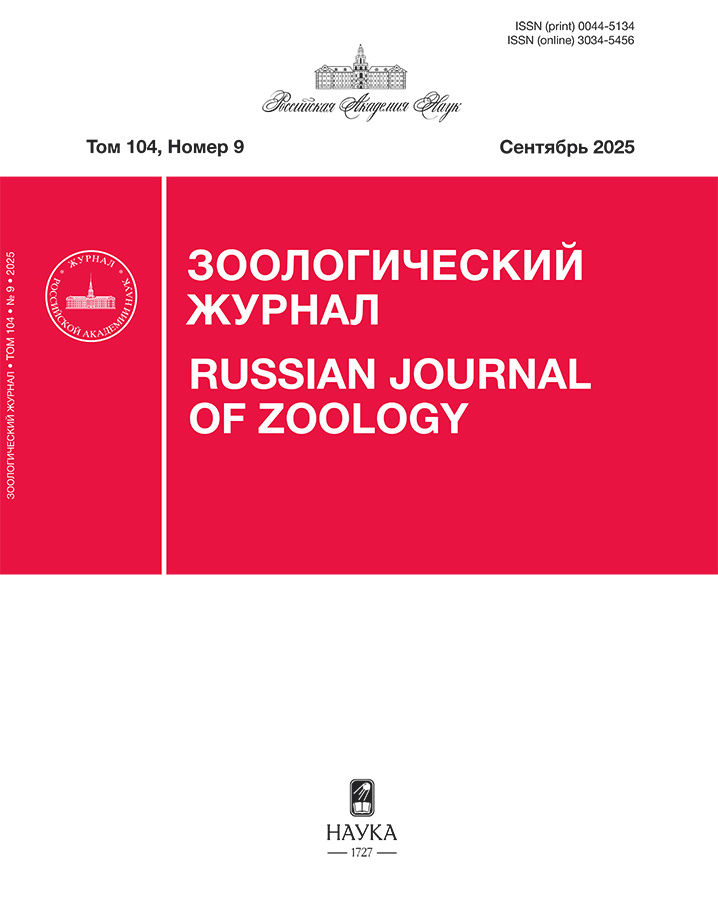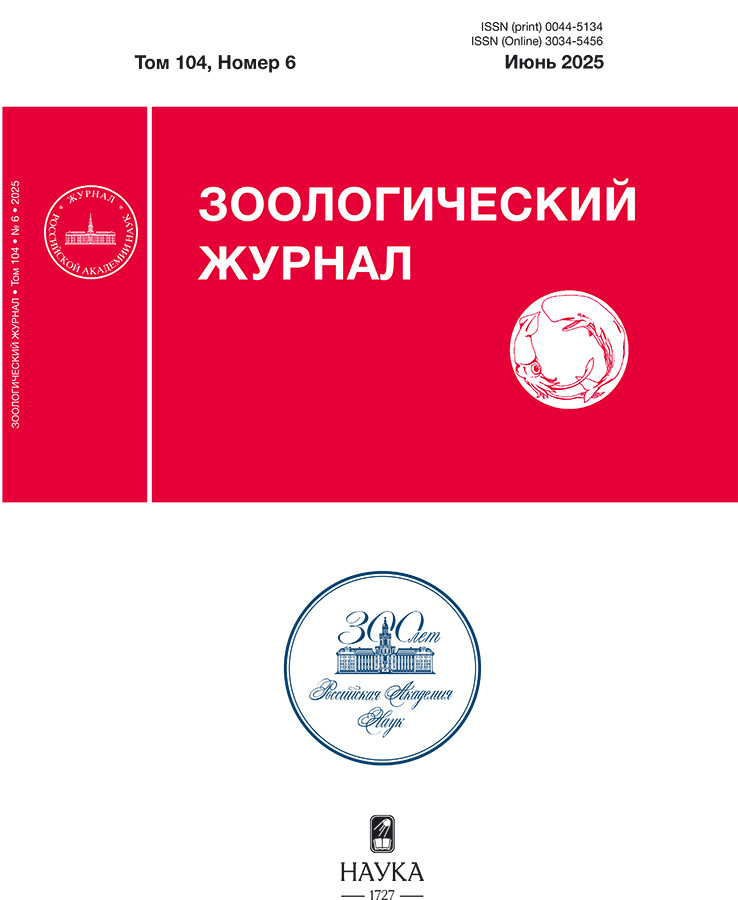Влияние погодных условий на активность обыкновенной полевки (Microtus arvalis Pallas, 1778, Cricetidae, Rodentia)
- Авторы: Толкачев О.В.1, Маклаков К.В.1
-
Учреждения:
- Институт экологии растений и животных УрО РАН
- Выпуск: Том 104, № 6 (2025)
- Страницы: 101-107
- Раздел: Статьи
- URL: https://ruspoj.com/0044-5134/article/view/687216
- DOI: https://doi.org/10.31857/S0044513425060093
- EDN: https://elibrary.ru/avzooo
- ID: 687216
Цитировать
Полный текст
Аннотация
Детальные знания о воздействии погоды на поведение мелких млекопитающих углубляют понимание экологии видов и помогают точнее интерпретировать результаты, получаемые в ходе полевых исследований. Хотя факт влияния погоды на активность мелких млекопитающих известен давно, результаты исследований часто противоречивы и варьируют в зависимости от вида, сезона и местообитания. В частности, для обыкновенной полевки существует лишь ограниченное количество исследований, рассматривающих узкий набор погодных параметров, с противоречивыми выводами. Целью исследования было изучение влияния различных погодных факторов на активность (преимущественно ночную) обыкновенных полевок в открытом биотопе в летний период. Для получения достаточно большого массива данных использована оригинальная методика оценки активности мелких млекопитающих по наличию отпечатков их лап в сети регулярно расположенных устройств для сбора следов. Исследование проводили в течение месяца на площади в 9 га, где размещалось 961 устройство. Каждое устройство состояло из пластиковой бутылки, следового картриджа (с водостойкими чернилами) и приманки. Обыкновенная полевка была доминирующим видом мелких млекопитающих в обследованном биотопе, что установлено интенсивным отловом зверьков в центральной части экспериментального участка. При промысловом усилии 10571 проверка регистрирующих устройств зафиксировано 6910 заходов полевок в устройства сбора отпечатков лап. Погодные показатели регистрировали с помощью автоматической метеостанции. Показано, что ветер, дождь, повышение температуры и влажности приводят к возрастанию активности обыкновенных полевок, а увеличение освещенности, напротив, снижает интенсивность передвижений. Использованный метод эффективен в получении больших массивов данных для оценки активности мелких млекопитающих в моновидовых сообществах.
Ключевые слова
Полный текст
Об авторах
О. В. Толкачев
Институт экологии растений и животных УрО РАН
Автор, ответственный за переписку.
Email: olt@mail.ru
Россия, 620144, Екатеринбург, ул. 8-го Марта, 202
К. В. Маклаков
Институт экологии растений и животных УрО РАН
Email: olt@mail.ru
Россия, 620144, Екатеринбург, ул. 8-го Марта, 202
Список литературы
- Башенина Н.В., 1962. Экология обыкновенной полевки и некоторые черты ее географической изменчивости. М.: МГУ. 308 с.
- Большаков В.Н., Баженов А.В., 1988. Радионуклидные методы мечения в популяционной экологии млекопитающих. М.: Наука. 157 с.
- Ердаков Л.Н., Николаев А.С., Фолитарек С.С., 2001. Активность и миграции // Водяная полевка: Образ вида. М.: Наука. С. 290–304.
- Ивантер Э.В., Макаров А.М., 2001. Территориальная экология землероек-бурозубок. Петрозаводск. 271 с.
- Карасева Е.В., Телицына А.Ю., Жигальский О.А., 2008. Методы изучения грызунов в полевых условиях. М.: Издательство ЛКИ. 416 с.
- Литвин В.Ю., Прошина Т.Ф., 1971. Разработка методик и опыт изучения контактов полевок-экономок с зараженными точками территории в природном очаге лептоспирозов // Зоологический журнал. T. 50. № 4. C. 572–581.
- Малкова Е.А., Толкачев О.В., Маклаков К.В., 2024. Нейросетевая идентификация по отпечаткам лап – новый подход к неинвазивной оценке видового разнообразия мелких млекопитающих // 80 лет экологической науке на Урале: материалы всероссийской научной конференции с международным участием, посвященной 80-летию Института экологии растений и животных УрО РАН, г. Екатеринбург, 11–15 ноября 2024 г. С. 140–141.
- Марвин М.Я., Орлова С.А., 1951. К вопросу о познании фауны мышевидных грызунов Карело-Финской ССР // Известия карело-финского филиала Академии наук СССР. № 3. С. 101–118.
- Наумов Н.П., 1948. Очерки сравнительной экологии грызунов. М.: Изд-во академии наук СССР. 204 с.
- Николаев А.С., Бушуева О.А., 1977. Сравнение гнездовой активности ушастой совы (Asio otus L.) с подвижностью мышевидных грызунов // Управление поведением животных. М.: Наука. С. 216–217.
- Николаев А.С., Чертова О.А., 1965. Влияние погодных условий на подвижность водяной крысы // Животный мир Барабы. Новосибирск: СО АН СССР. С. 70–72.
- Николаев А.С., Лузина Н.В., Панов В.В., 1977а. Зашумленность биотопов и ее влияние на активность пернатых хищников и мышевидных грызунов // Эколого-физиологические исследования в природе и эксперименте. Фрунзе: “Ылым”. С. 55–56.
- Николаев А.С., Панов В.В., Лузина Н.В., 1977б. Использование методик-и сплошной записи поведения животных для сравнительного анализа активности // Эколого-физиологические исследования в природе и эксперименте. Фрунзе: “Ылым”. С. 54–55.
- Фолитарек С.С., Максимов А.А., 1959. Сезонные кочевки, подвижность и активность водяной крысы // Водяная крыса и борьба с ней в западной Сибири. Новосибирск: Новосибирское кн. изд-во. 476 с.
- Ялковская Л.Э., Чепраков М.И., Ракитин С.Б., Полявина О.В., 2017. Местообитания видов-двойников группы “arvalis” (Microtus, Arvicolinae, Rodentia) на территории крупных городов среднего Урала // Зоологический журнал. Т. 96. № 6. С. 711–719.
- Barton K., 2020. MuMIn: Multi-Model Inference. R package version 1.43.17. https://CRAN.R-project.org/package=MuMIn
- Baulmer W., 1975. Activity of Some Small Mammals in the Field // Acta Theriologica. V. 20. P. 365–377.
- Bider J.R., 1968. Animal Activity in Uncontrolled Terrestrial Communities as Determined by a Sand Transect Technique // Ecological Monographs. V. 38. № 4. P. 269–308.
- Blair W.F., 1951. Population structure, social behavior, and environmental relations in a natural population of the beach mouse (Peromyscus polionotus leucocephalus) // Contributions from the laboratory of vertebrate biology university of Michigan. № 48. P. 1–47.
- Burnham K.P., Anderson D.R., 2002. Model Selection and multimodel inference – a practical information-thoretic approach. New York: Springer Science + Business Media. 488 p.
- Clarke J.A., 1983. Moonlight’s influence on predator/prey interactions between short-eared owls (Asio flammeus) and deermice (Peromyscus maniculatus) // Behav. Ecol. Sociobiol. V. 13. P. 205–209.
- Evans F.C., 1942. Studies of a small mammal population in Bagley wood, Berkshire // Journal of animal ecology. V. 11. № 2. P. 182–197.
- Fanson B.G., 2010. Effect of direct and indirect cues of predation risk on the foraging behavior of the White-footed mouse (Peromyscus leucopus) // Northeastern naturalist. V. 17. № 1. P. 19–28.
- Gillies C.A, Williams D., 2013. DOC tracking tunnel guide v2.5.2: Using tracking tunnels to monitor rodents and mustelids. Department of Conservation, Science & Capability Group, Hamilton, New Zealand. 14 p.
- Halle S., 1995. Effect of extrinsic factors on activity of Root voles, Microtus oeconomus // Journal of mammalogy. V. 76. № 1. P. 88–99.
- Justice K.E., 1961. A new method for measuring home ranges of small mammals // Journal of Mammalogy. V. 42. № 4. С. 462–470.
- Jensen S.P., Honess P., 1995. The influence of moonlight on vegetation height preference and trappability of small mammals // Mammalia. V. 59. № 1. P. 35–42.
- King C.M., Edgar R.L., 1977. Techniques for trapping and tracking stoats (Mustela erminea); a review, and a new system // New Zealand Journal of Zoology. V. 4. № 2. P. 193–212.
- Kotler B.P., 1984. Risk of predation and the structure of desert rodent communities // Ecology. V. 65. № 3. P. 689–701.
- Kryštufek B., Shenbrot G.I., 2022. Voles and Lemmings (Arvicolinae) of the Palaearctic Region. Maribor: University Press. 437 p.
- Lehmann U., Sommersberg C.W., 1980. Activity patterns of the Common vole, Microtus arvalis – automatic recording of behaviour in an enclosure // Oecologia. V. 47. P. 61–75.
- Maestri R., Marinho J.R., 2014. Singing in the rain. Rainfall and moonlight affect daily activity patterns of rodents in a Neotropical forest // Acta Theriologica. V. 59. P. 427–433.
- Marten G.G., 1973. Time patterns of Peromyscus activity and their correlations with weather // Journal of mammalogy. V. 54. № 1. P 169–188.
- O’Farrell M.J., 1974. Seasonal activity patterns of rodents in a sagebrush community // Journal of mammalogy. V. 55. № 4. P. 809–823.
- Palma A.R.T., Gurgel-Goncalves R., 2007. Morphometric identification of small mammal footprints from ink tracking tunnels in the Brazilian Cerrado // Revista Brasileira de zoologia. V. 24. № 2. P. 333–343.
- Pasquet A., Torre I., Diaz M., 2023. Indirect human influences in fear landscapes: varying effects of moonlight on small mammal activity along man-made gradients of vegetation structure // Life. V. 13. 681.
- Prugh L.R., Golden C.D., 2014. Does moonlight increase predation risk? Meta-analysis reveals divergent responses of nocturnal mammals to lunar cycles // Journal of animal ecology. V. 83. P. 504–514.
- R Core Team, 2024. R: a language and environment for statistical computing. R Foundation for Statistical Computing, Vienna, Austria. https://www.R-project.org/
- Rizkalla C.E., Swihart R.K., 2007. Explaining movement decisions of forest rodents in fragmented landscapes // Biological conservation. V. 140. P. 339–348.
- Vickery W.L., Bider J.R., 1981. The influence of weather on rodent activity // Journal of mammalogy. V. 62. № 1. P. 140–145.
- Vickery W.L., Rivest D., 1992. The influence of weather on habitat use by small mammals // Ecography. V. 15. P. 205–211.
- Wrobel A., Bogdziewicz M., 2015. It is raining mice and voles: which weather conditions influence the activity of Apodemus flavicollis and Myodes glareolus? // European journal of wildlife research. V. 61. P. 475–478.
Дополнительные файлы













